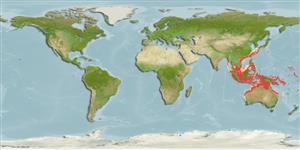Environment: milieu / climate zone / depth range / distribution range
Ecologia
marinhas demersal. Tropical
Western Pacific: Taiwan and the South China Sea to Australia (Darwin to North West Cape).
Tamanho / Peso / Idade
Maturity: Lm ? range ? - ? cm
Max length : 20.0 cm SL macho/indeterminado; (Ref. 9774); common length : 12.5 cm SL macho/indeterminado; (Ref. 9774)
Espinhos dorsais (total) : 0; Raios dorsais moles (total) : 68 - 72; Espinhos anais: 0; Raios anais moles: 52 - 55; Vértebras: 33 - 35. Body uniformly brownish, 2 ocelli above and below lateral line and 1 ocellus on posterior third of straight section of lateral line. Many indistinct rings scattered on body and median fins. Teeth in upper jaw small and close-set with3 or 4 pairs of canines anteriorly, teeth in lower jaw stronger and more widely spaced than those in upper jaw. Gill rakers pointed and rather short. Pectoral fin on ocular side with 12-13 rays (Ref 9774).
Inhabits deep waters on mud and sand bottoms of the continental shelf (Ref. 9774). Feeds on benthic animals (Ref. 4896). Marketed fresh and salt-dried (Ref. 9774).
Life cycle and mating behavior
Maturities | Reprodução | Spawnings | Egg(s) | Fecundities | Larvas
Distinct pairing (Ref. 205).
Sainsbury, K.J., P.J. Kailola and G.G. Leyland, 1985. Continental shelf fishes of the northern and north-western Australia. An illustrated guide. CSIRO Division of Fisheries Research; Clouston & Hall and Peter Pownall Fisheries Information Service, Canberra, Australia. 375 p. (Ref. 3131)
Categoria na Lista Vermelha da IUCN (Ref. 130435)
Ameaça para o homem
Harmless
Utilização humana
Pescarias: espécies comerciais
Ferramentas
Relatórios especiais
Descarregue XML
Fontes da internet
Estimates based on models
Preferred temperature (Ref.
123201): 24.3 - 29, mean 28 °C (based on 1590 cells).
Phylogenetic diversity index (Ref.
82804): PD
50 = 0.5000 [Uniqueness, from 0.5 = low to 2.0 = high].
Bayesian length-weight: a=0.00631 (0.00374 - 0.01065), b=3.12 (2.97 - 3.27), in cm total length, based on LWR estimates for this species & Genus-body shape (Ref.
93245).
Nível Trófico (Ref.
69278): 3.5 ±0.37 se; based on food items.
Resiliência (Ref.
120179): Elevada, tempo mínimo de duplicação da população menor que 15 meses (Preliminary K or Fecundity.).
Fishing Vulnerability (Ref.
59153): Low vulnerability (14 of 100).
